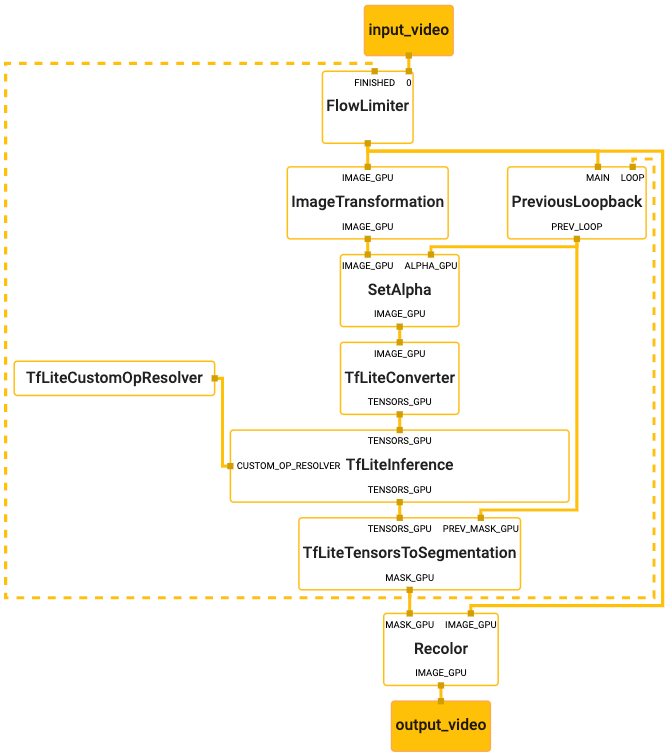7.9 KiB
Hair Segmentation on Desktop
This is an example of using MediaPipe to run hair segmentation models
(TensorFlow Lite) and render a color to the detected hair. To know more about
the hair segmentation models, please refer to the model README file.
Moreover, if you are interested in running the same TensorfFlow Lite model on
Android/iOS, please see the
Hair Segmentation on GPU on Android/iOS and
We show the hair segmentation demos with TensorFlow Lite model using the Webcam:
Note: If MediaPipe depends on OpenCV 2, please see the known issues with OpenCV 2 section.
TensorFlow Lite Hair Segmentation Demo with Webcam (GPU)
Note: This currently works only on Linux, and please first follow OpenGL ES Setup on Linux Desktop.
To build and run the TensorFlow Lite example on desktop (GPU) with Webcam, run:
# Video from webcam running on desktop GPU
# This works only for Linux currently
$ bazel build -c opt --copt -DMESA_EGL_NO_X11_HEADERS --copt -DEGL_NO_X11 \
mediapipe/examples/desktop/hair_segmentation:hair_segmentation_gpu
# It should print:
#INFO: Found 1 target...
#Target //mediapipe/examples/desktop/hair_segmentation:hair_segmentation_gpu up-to-date:
# bazel-bin/mediapipe/examples/desktop/hair_segmentation/hair_segmentation_gpu
#INFO: Build completed successfully, 12210 total actions
# This will open up your webcam as long as it is connected and on
# Any errors is likely due to your webcam being not accessible,
# or GPU drivers not setup properly.
$ GLOG_logtostderr=1 bazel-bin/mediapipe/examples/desktop/hair_segmentation/hair_segmentation_gpu \
--calculator_graph_config_file=mediapipe/graphs/hair_segmentation/hair_segmentation_mobile_gpu.pbtxt
Graph
To visualize the graph as shown above, copy the text specification of the graph below and paste it into MediaPipe Visualizer.
# MediaPipe graph that performs hair segmentation with TensorFlow Lite on GPU.
# Used in the example in
# mediapipe/examples/android/src/java/com/mediapipe/apps/hairsegmentationgpu.
# Images on GPU coming into and out of the graph.
input_stream: "input_video"
output_stream: "output_video"
# Throttles the images flowing downstream for flow control. It passes through
# the very first incoming image unaltered, and waits for
# TfLiteTensorsToSegmentationCalculator downstream in the graph to finish
# generating the corresponding hair mask before it passes through another
# image. All images that come in while waiting are dropped, limiting the number
# of in-flight images between this calculator and
# TfLiteTensorsToSegmentationCalculator to 1. This prevents the nodes in between
# from queuing up incoming images and data excessively, which leads to increased
# latency and memory usage, unwanted in real-time mobile applications. It also
# eliminates unnecessarily computation, e.g., a transformed image produced by
# ImageTransformationCalculator may get dropped downstream if the subsequent
# TfLiteConverterCalculator or TfLiteInferenceCalculator is still busy
# processing previous inputs.
node {
calculator: "FlowLimiterCalculator"
input_stream: "input_video"
input_stream: "FINISHED:hair_mask"
input_stream_info: {
tag_index: "FINISHED"
back_edge: true
}
output_stream: "throttled_input_video"
}
# Transforms the input image on GPU to a 512x512 image. To scale the image, by
# default it uses the STRETCH scale mode that maps the entire input image to the
# entire transformed image. As a result, image aspect ratio may be changed and
# objects in the image may be deformed (stretched or squeezed), but the hair
# segmentation model used in this graph is agnostic to that deformation.
node: {
calculator: "ImageTransformationCalculator"
input_stream: "IMAGE_GPU:throttled_input_video"
output_stream: "IMAGE_GPU:transformed_input_video"
node_options: {
[type.googleapis.com/mediapipe.ImageTransformationCalculatorOptions] {
output_width: 512
output_height: 512
}
}
}
# Caches a mask fed back from the previous round of hair segmentation, and upon
# the arrival of the next input image sends out the cached mask with the
# timestamp replaced by that of the input image, essentially generating a packet
# that carries the previous mask. Note that upon the arrival of the very first
# input image, an empty packet is sent out to jump start the feedback loop.
node {
calculator: "PreviousLoopbackCalculator"
input_stream: "MAIN:throttled_input_video"
input_stream: "LOOP:hair_mask"
input_stream_info: {
tag_index: "LOOP"
back_edge: true
}
output_stream: "PREV_LOOP:previous_hair_mask"
}
# Embeds the hair mask generated from the previous round of hair segmentation
# as the alpha channel of the current input image.
node {
calculator: "SetAlphaCalculator"
input_stream: "IMAGE_GPU:transformed_input_video"
input_stream: "ALPHA_GPU:previous_hair_mask"
output_stream: "IMAGE_GPU:mask_embedded_input_video"
}
# Converts the transformed input image on GPU into an image tensor stored in
# tflite::gpu::GlBuffer. The zero_center option is set to false to normalize the
# pixel values to [0.f, 1.f] as opposed to [-1.f, 1.f]. With the
# max_num_channels option set to 4, all 4 RGBA channels are contained in the
# image tensor.
node {
calculator: "TfLiteConverterCalculator"
input_stream: "IMAGE_GPU:mask_embedded_input_video"
output_stream: "TENSORS_GPU:image_tensor"
node_options: {
[type.googleapis.com/mediapipe.TfLiteConverterCalculatorOptions] {
zero_center: false
max_num_channels: 4
}
}
}
# Generates a single side packet containing a TensorFlow Lite op resolver that
# supports custom ops needed by the model used in this graph.
node {
calculator: "TfLiteCustomOpResolverCalculator"
output_side_packet: "op_resolver"
node_options: {
[type.googleapis.com/mediapipe.TfLiteCustomOpResolverCalculatorOptions] {
use_gpu: true
}
}
}
# Runs a TensorFlow Lite model on GPU that takes an image tensor and outputs a
# tensor representing the hair segmentation, which has the same width and height
# as the input image tensor.
node {
calculator: "TfLiteInferenceCalculator"
input_stream: "TENSORS_GPU:image_tensor"
output_stream: "TENSORS_GPU:segmentation_tensor"
input_side_packet: "CUSTOM_OP_RESOLVER:op_resolver"
node_options: {
[type.googleapis.com/mediapipe.TfLiteInferenceCalculatorOptions] {
model_path: "mediapipe/models/hair_segmentation.tflite"
use_gpu: true
}
}
}
# Decodes the segmentation tensor generated by the TensorFlow Lite model into a
# mask of values in [0.f, 1.f], stored in the R channel of a GPU buffer. It also
# takes the mask generated previously as another input to improve the temporal
# consistency.
node {
calculator: "TfLiteTensorsToSegmentationCalculator"
input_stream: "TENSORS_GPU:segmentation_tensor"
input_stream: "PREV_MASK_GPU:previous_hair_mask"
output_stream: "MASK_GPU:hair_mask"
node_options: {
[type.googleapis.com/mediapipe.TfLiteTensorsToSegmentationCalculatorOptions] {
tensor_width: 512
tensor_height: 512
tensor_channels: 2
combine_with_previous_ratio: 0.9
output_layer_index: 1
}
}
}
# Colors the hair segmentation with the color specified in the option.
node {
calculator: "RecolorCalculator"
input_stream: "IMAGE_GPU:throttled_input_video"
input_stream: "MASK_GPU:hair_mask"
output_stream: "IMAGE_GPU:output_video"
node_options: {
[type.googleapis.com/mediapipe.RecolorCalculatorOptions] {
color { r: 0 g: 0 b: 255 }
mask_channel: RED
}
}
}
